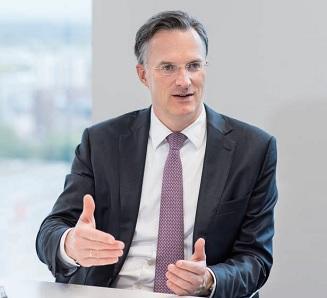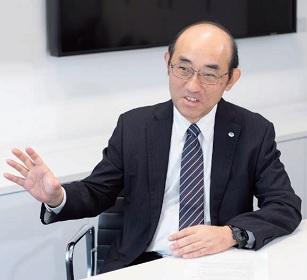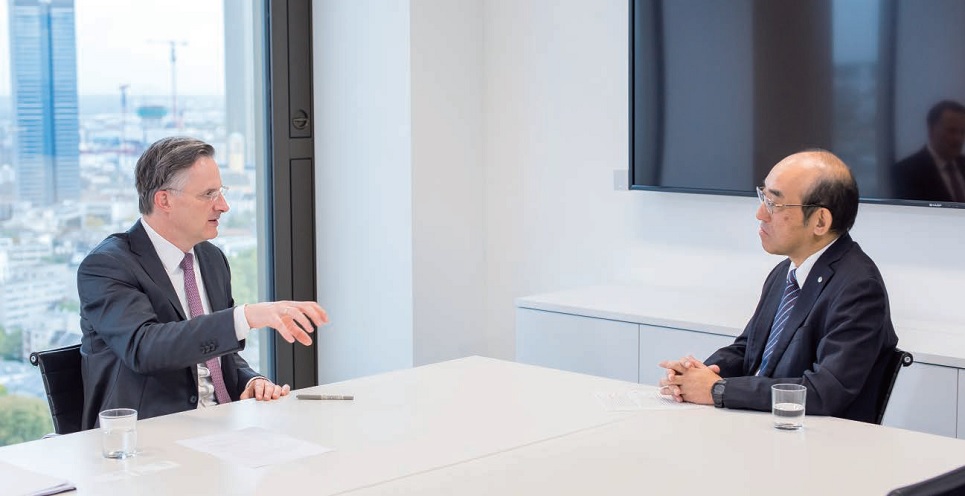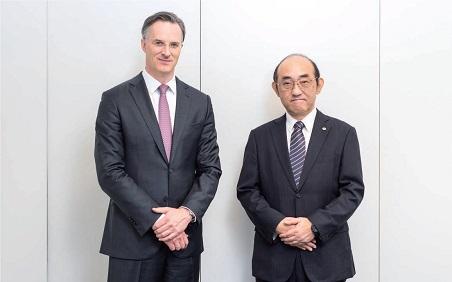Interviews with experts and opinion leaders from our research network
Automakers have been accelerating their investments in developing electric vehicles (EVs) and autonomous driving vehicles. With these new developments, the business environment for the automotive industry is changing dramatically. We invited Marcus Berret, Senior Partner and Chairman of the Supervisory Board of Roland Berger, a global strategy consulting firm headquartered in Munich, Germany to discuss how the automotive industry will be changing.

Marcus Berret is the Chairman of the Supervisory Board at Roland Berger. After joining the company in 1997, he supported clients in the German automotive industry and managed Roland Berger’s global business with automotive suppliers. He was elected Partner in 2003. His first appointment to the Supervisory Board came in September 2013, where he took over the role of Deputy Chairman. In addition, Marcus Berret has been head of Roland Berger's global automotive competence center since 2014. He is also the Partner with global responsibility of Roland Berger’s Competence Center Engineered Products & High Tech (EPHT) as well as the global Competence Center for Operations Strategy.
Shirai: I would like to start by asking you about the next generation of vehicles. After 2020, more and more vehicles made will be shifting over to EVs. Autonomous driving vehicles will be seen in greater and greater numbers as well. With these changes, cars may become just a means of transportation rather than luxury items. What do you think consumers will expect and require from these next generation cars in the future? Will consumers expect new and different things from these new and different cars?
Marcus Berret: Some basic customer expectations will not change, like comfort, security, connectivity, quality, and reliability, so we do not expect significant changes in those areas.
However, there are two significant changes that we do expect. The first is the rapid increase in use of electric vehicles, which is mainly driven by regulation. That is a very special driving force. It is not as if consumers have suddenly been demanding electric vehicles; rather, it is only due to this new regulatory situation. The second big change in expectations is around autonomous driving vehicles. At the moment, people do not know exactly what to expect, because most people have never even been in an autonomous driving car.
Therefore, I think that the dominating topic until 2021 will be EVs. In Europe, the market share for diesel vehicles will decrease from more than 50% to around 25%. Every gasoline-powered car that replaces a diesel car adds 10 grams of CO2 to an OEM’s bill. The only way to offset that is to make a very strong push towards electric vehicles. It is pure math, as you can calculate very easily what the share of electric vehicles each OEM needs to have. That is not a real end-consumer push, but a regulatory push. Autonomous driving, however, is very different. There will be a very strong end-consumer push once people understand the benefits that will be coming from this.
Have you been in an autonomous car?
Shirai:Not yet.
Marcus Berret: Once you go somewhere in an autonomous car, it flips a switch in your mind, because you immediately understand how much more convenient this is going to be. This whole issue of autonomous driving will be a much, much more significant game-changer in our industry than electric vehicles.
Shirai:In this emerging new environment, will the value and place for cars in people’s lives be transformed?
Marcus Berret: Yes, these will certainly change.
Shirai:How do you think that manufacturers will appeal to drivers or users? Recently, the president of Toyota said, “Yeah, fun to drive.” What’s the fun of driving in that situation? As the experience of driving changes, how will car manufacturers promote their products? Will they need to appeal differently to users? Will there be greater competition on price or customization for comfort or other after-sales upgrades? What will become the new selling points for users?
Marcus Berret: I think that the major point is the real user-centric attitude of the OEMs. For most of today’s drivers, the main purpose in buying a car is not about the brand of the car or its particular features or fuel economy. People want to get from point A to point B. The most common and the most outstanding means for you to get from point A to point B is to own a car and drive it from point A to point B.
When you suddenly have autonomous driving vehicles, you can have a service pick you up and take you from point A to point B for about 20% of what you would spend today. Today, if you take a taxi or an Uber, it is incredibly expensive. It is very expensive even if you use a car-sharing vehicle.
80% of the costs for car-sharing and taxi companies are personnel costs. Even in a car-sharing model, like Car2Go or DriveNow here in Germany, which is from BMW and Daimler, the biggest costs are personnel costs. That is because people leave cars here, but then you need to have someone drive it back to where the next user needs it. People leave cars in a parking space without a plug, so you need to send someone out there to recharge them or service them and things like that. But when you have autonomous driving vehicles, 80% of the personnel costs go away, and this will allow users to think in much more flexible ways and allow for much more flexible business models.
Shirai:That suggests a real change in terms of practicality and cost. How is that going to change things for vehicle manufacturers and the way they market vehicles to consumers?
Marcus Berret: The OEMs will need to think about real user centricity. The second major point is that OEMs need to find ways to maintain relationships with users in this new world, because the relationship is not about the brand of the car anymore. I would go so far as to say that in 10 years, if you are picked up by a RoboCab, you will not really care about the brand. You will just want to go safely from point A to point B. Thus, OEMs need to find new ways to connect with consumers through seamless mobility*1.
Shirai:Seamless mobility will become important moving forward?
Marcus Berret: Yes. Seamless mobility will be the absolute key in the future.
Shirai:I would like to talk about EVs for a moment. It is said that EVs are easier to assemble as they have less physical components than internal combustion engine vehicles which use gasoline or diesel. As such, we can easily predict that there would be newcomers, or new entrants into the marketplace, especially Chinese or Indian companies. These kinds of newcomers could rapidly expand their presence in the market. What would be key factors for companies that are thinking about taking initiatives in this changing marketplace under these new circumstances?
Marcus Berret: Do you mean from the OEM’s perspective?
Shirai::Well, actually I was asking more about what kinds of companies could take such initiatives, what kinds of key factors they need to be thinking about, and what kinds of challenges they might expect to face. Is it mainly about capabilities for mass production and developing economies of scale? Or are there other critical issues and new factors to consider?
Marcus Berret: You are completely right in terms of the EV scenario. It will take a long time until the conventional powertrain disappears, but in the EV scenario, the entry barrier for new companies in the business is reduced because they are much easier to manufacture. 25% of the entire value of the vehicle is simply in the batteries, so there is a huge shift with significantly fewer components. From my point of view, the key factor for success for an OEM will be to maximize levels of efficiency.
Shirai:Could you explain why is that going to be critical?
Marcus Berret: The situation here is that the regulatory environment forces OEMs to sell more EVs to reduce emissions. Customers may be willing to buy EVs, as even though they are less convenient because of the reduced range, they come with a certain security of being allowed to enter some cities. I think customers will be okay with driving EVs, but certainly not at the price the OEMs would have to charge to maintain their profit margins. EVs are much more expensive, but consumers do not care. In the volume segment, if you increase the price by $1,000, you would have an immediate drop in sales volume.
Shirai:That is a very interesting dynamic.
Marcus Berret: There is a very sensitive price-volume relationship, but the OEM has to sell EVs in order to be compliant with the regulations on overall emissions.

There will be tremendous pressure on the OEMs to increase their efficiency levels and address the cost side of the equation to maintain margins in a new business area where the average margin will be much lower than with their traditional vehicles.
Shirai:That sounds incredibly challenging.
Marcus Berret: The dilemma for OEMs today is replacing profitable or highly profitable existing business with less profitable or unprofitable EV business. Therefore, the key factor to success for them will be to maximize efficiency at every level. The second key factor for success will be around mobility. An example of this is how Tesla is offering charging stations and a mobile service to connect customers. This will be a second key factor for success for OEMs over the next several years.
Shirai:Recently, several governments have already announced big changes. France and the UK will both stop the sale of gasoline and diesel cars in 2040. In China as well,
10% of new cars in 2019 will be so-called NEVs, or New Energy Vehicles.
Marcus Berret: Yes.
Shirai:In the United States, 80% of new cars sold in California will be zero emission vehicles in 2019. Considering each government’s policies and challenges, which country or region will be a leading market for EVs?
Marcus Berret: There is no question in my mind that China will be the leading market.
Shirai:Really?
Marcus Berret: Already China is by far the leading EV-market, covering around 40% of the worldwide market volume. China is imposing very strict regulations, so it will continue to remain the leading market. Europe will follow and will become the second most important EV market in the future. In the U.S., the EV market mainly exists in California. For the rest of the U.S., the types of cars and user profiles are very different and it will take a long time until things change in the U.S. China is really leading the way when it comes to EV. Yet in terms of connected mobility*2 in Asia, South-Korea and Singapore are experiencing very rapid development.
Shirai:That means there will be a big chance for Chinese automotive companies and big challenges for the European and Japanese automakers.
Marcus Berret: Absolutely. China has clearly understood that they need to change the competitive situation in the car industry. Chinese car manufacturers have not really been successful over the past two decades, but the new regulations will offer a systematic advantage for local car manufacturers, which is part of the reason why the government is pushing them. Of course, other factors also include the environment, air quality, and aspects related to that.
Shirai:I would also like to talk about this new world of autonomous driving cars. Autonomous driving vehicles require all kinds of new technologies, new software, artificial intelligence, many kinds of sensors, and communication technologies. This new world is creating a whole new market or perhaps many new markets. There will be newcomers and different players in the new automotive landscape, such as IT companies, software companies, and chip manufacturers, among others. What do you think will be the key factors, and what will be key technologies and opportunities for companies to take initiatives in this new market?
Marcus Berret: The development of battery technology and charging systems will play a key role in autonomous driving and the EV-market as well. Also key to autonomous driving is everything involved with vision systems, laser cameras and LIDAR*3, or near range radar systems – everything related to detection and vision. Then there is the area involving mapped data and the computing power to deal with such data. I would say those are key technology areas.

This is why Intel acquired Mobileye and why further big moves are happening. One of the main challenges for OEMs is to completely change their software architecture. In fact, one of the big advantages for Tesla was that they started from scratch in building their software architecture*4.
Shirai:Do you mean that existing OEMs are at a disadvantage?
Marcus Berret: The existing OEMs have so many legacy systems which have piled up over time. Allow me to provide an example: I recently drove the new Tesla Model S Facelift. When I had to drive down into my garage, it was a bit of a steep angle going down. I needed to adjust the air suspension to raise the car up to make sure that it would not have any problems with scraping or bottoming out. The next day, I was driving toward my home and I went to adjust the air suspension to raise the car up, but nothing happened. I realized that it was already in the raised position. The software recognized via GPS that the car is at the same place as the day before and adjusted the air suspension automatically. This is fantastic!
A European or Japanese car could never do this. The data is there, but the problem is that it is distributed in many different pieces of software. There is no easy way to connect
or communicate between all those various separate systems. This whole area of software architecture will probably be the third area that will create many new growth opportunities.
Shirai:The automotive industry is a huge employer both in Germany as well as in Japan, but some portion of that employment could be lost in these changing circumstances. Also, many people work with Tier 2 and Tier 3 suppliers, and employment will likely also be affected for those suppliers. In regards to this new situation, what kinds of measures should be taken in countries that have so many people working in the automotive sector? What should governments be doing to respond to these new circumstances?
Marcus Berret: Well, this is actually a very tricky subject. In Germany, the automotive industry currently employs between 800,000 and a million people. On top of that, many other jobs depend on the automotive industry. Thus the automotive industry is the country’s biggest employer, working with traditional power trains involving engines, turbo chargers, emission systems and exhaust systems. Yet the new power trains will involve up to 90% less manual work. That means a huge change for the automotive industry and a huge challenge for the employment situation in Germany. If only 25% of vehicles shift to electric there will be a major impact on the existing power train plants of both the suppliers and the OEMs.
Shirai:Is there any way to mitigate the impact of this?
Marcus Berret: The only way to keep the job market stable or compensate for this reduction is to make sure that at least the volume of cars produced remains stable. This means that the technology of the cars must be successful and match the needs of customers. From my point of view, this is what governments have to push for because the transformation is happening quickly. Thus we need an open discussion in Europe with all involved parties: the politicians, the automotive industry, their employees and the customers as well. Anyway we should avoid a protected system in Europe against important developments like autonomous driving, because this would not lead to a globally competitive car industry in Europe.
Shirai:My next question is not so much about the automotive industry but rather about the mobility services that you have mentioned. Even now, there are many mobility services, such as shared vehicles and ride sharing. These services provide value in transportation through new business models. There are new entrants and those new entrants are now increasing.
Also, autonomous driving cars are expected to accelerate this trend even further. Which players do you think will be able to take the initiative and succeed with these mobility services?
Marcus Berret: The OEMs are investing billions in new mobility services. I am convinced that in 10 or 15 years the core business of an OEM will not be to sell cars anymore, but to sell mobility to end users. People will need more mobility services in the future and the OEMs are strongly investing here. Further, a lot of independent startup companies are working in this field. Also tech giants like Google® and Apple ® are fighting for their portion of this growing market.

Shirai:Then the real question is who will be profiting in this new world of mobility?
Marcus Berret: The global profit pool of the automotive industry is around $500 billion a year and will continue to grow, because customers are asking globally for individual mobility. People – even the older generation – are traveling more. Therefore, individual mobility needs will probably grow by 3–5% per year. In the meantime we believe that new players could absorb up to 40% of the global profit generated by the automotive sector. I call this a vacuum cleaner.
Shirai:A vacuum cleaner? Could you explain what you mean by that?
Marcus Berret: It reminds me of a vacuum cleaner, if I imagine 40% of the profit pool being sucked away by new market entrants. That means there is only little more than half of the profit left for the established industry players – a potential disaster. This is why the OEMs are investing so heavily in innovative start-ups, in order to save their profit pool.
Shirai:Will this new area of mobility services see severe competition?
Marcus Berret: Many players in the industry will try to become mobility providers, but I am convinced that in the end there will only be a few players remaining. In fact, data-driven business models automatically work toward monopolies because of the big efficiencies of scale. In the end, only a few mobility platforms will survive because end customers want to have a big fleet available. They want to make sure that the platform knows their profile and their preferences. They want to have an identical feeling and identical service with each usage. No one wants to operate as a user on four or five different platforms, needing separate credit authorizations and contracts for each one.
Shirai:Another idea is that autonomous driving might reduce the value of transportation, and it may be difficult to make money with just mobility services. One of the assumptions is that in the end mobility services might need to be integrated with other services, such as health care or entertainment. Do you think those kinds of players will be a big part of the new picture? Will mobility services become a piece of other services?
Marcus Berret: Yes, this could be the third step of a longer process. The first step is autonomous mobility, which is the key for cheaper mobility services. Today, none of the mobility companies are profitable because their services are still too expensive. The switch from a driver to the autonomous driving will cut around 80% of the costs. But to establish this technology, you need 5G communications for mobile data transfer. That means that significant investments for sensors and data centers in the cities are urgently needed.
In the second step a few high-efficient platforms will emerge in the whole system. Then the third step could be a further integration of services, a kind of flat rate for mobile communication, individual transportation, health insurance, movies, TV and digital radio stations all together. I am pretty sure such a service will exist in the future, but there is still a long way to go.
Shirai:When discussing autonomous driving, I think it is important that we talk about security and safety. Before autonomous driving cars over Level 3 prevail, they will require safety regulations which should protect consumers but also should not obstruct technological development. I think a balance is important. How is each government addressing these regulations?
Marcus Berret: Governments are pushing for autonomous driving as they aim to improve safety on the roads. 1.3 million people worldwide are killed every year by road accidents, while roughly 50 million people are injured. Many governments have put a zero-casualty policy in place, so the vision is to move towards zero people killed in traffic. The same goes for Germany, where around 3,300 to 3,500 people per year are killed in traffic accidents. That is why governments and authorities would like to push for autonomous driving, because the number of accidents could be greatly reduced.
Shirai:Autonomous driving vehicles are always online and connected to the internet. This provides convenience for users, but the risk of a cyber-attack through hacking requires more attention than ever. How should stakeholders deal with those risks?
Marcus Berret: There is a real risk in data and IT security, but at the same time everyone is working diligently on firewalls and protected systems. Today, we have airplanes that are more or less flying fully automated, all based on IT and air traffic control systems. I think that the same thing will happen for car traffic. Everyone is putting up hurdles and of course you will sometimes have safety incidents, but the key is finding the right balance. Currently, 1.3 million people are killed each year in automobile accidents and that situation is far from ideal. Even if you have some uncontrolled accidents due to data hacking, I think that the judgement on balance will still be very much in favor of the autonomous driving systems. Data protection, of course, will be a number one priority in this whole endeavor.
Shirai:Volkswagen in Germany and Toyota in Japan are two very successful leaders in the global automotive industry, but the industry is shifting. There is a risk that the big players could encounter a big innovation dilemma, and there are two possible scenarios as I see it. The two big players can respond and shift to the new market, and they may be able to retain their current positions. That might not be the automotive industry as we understand it today, but perhaps a service mobility kind of industry. Nevertheless, they could maintain a big presence in the car-related market. Another scenario is that Chinese auto makers or newcomers like Tesla will expand their presence, and Toyota and Volkswagen will lose the current position. What do you foresee happening?
Marcus Berret: All the trends that we have discussed today are evolving rapidly. Two or three years ago, we might have said that maybe we will see a move toward autonomous mobility. Three years ago, we would have said maybe there would be a growing move toward electric mobility.

However, both ideas were still a bit theoretical. Everybody knew these things could happen, but the economic driving forces were not particularly strong. Today everybody accepts these clear trends. We are not looking at two completely different possible market scenarios, but we are seeing these two ideas, EV and autonomous driving, clearly converging. As a consequence a much higher percentage of vehicles are going to be shared vehicles and not owned by individual end users. Do you know the concept of friction-free business segments?
Shirai:Friction-free?
Marcus Berret: Friction-free is one of the best ways I can explain the transformation we are currently going through. Each economic segment in the world – from legislation, technology, user habits, or an industry perspective – will move towards the state of lowest possible friction as soon as possible.
We have seen this happening with digital cameras, music, movies, and television, etc. For example, five years ago, you had to be home on time to see a news broadcast. Today, the news is streamed and you can see it anywhere, at any time. This is friction-free and it is much cheaper and much more user-friendly.
If you look at the automotive industry, 1.3 million people are killed each year. There are $500 billion a year in damage to vehicles in accidents. Then there are seven gigatons of CO2 being generated by the automotive sector each year. We have much work to do to be in compliance with the Paris Agreement.
We also have a problem of asset productivity. You buy a car for $50,000, $80,000 or $100,000, and then you use it only 3% or 4% of the time. This is a waste of asset productivity, but most of us do not have alternative services. Thus all aspects converge to the lowest friction as possible in the automotive industry from a user perspective. This involves a growing percentage of electric vehicles, a growing percentage of fully autonomous vehicles, and a growing percentage of shared vehicles not owned by individual end users.
Shirai:If the trend is toward friction-free mobility, how will this fundamentally change the landscape of the automotive industry?
Marcus Berret: In the coming years we will see strong pressure on margins in the automotive industry. Among the trends we discussed, there is only one piece of good news for the OEMs: individual mobility is increasing. All the other elements – electric vehicles, shared mobility, mobility platforms, autonomous driving – are mainly negative for the established OEMs. Their margins are in danger. All the OEMs will work hard to fight this margin erosion through increased efficiency and standardization. Thus we will see a heavy consolidation among OEMs.
The best analogy to look at it is the automotive supplier industry, which is a highly efficient B2B environment. You basically have ten possible customers that are OEMs, and you have a portfolio of suppliers offering components. No matter what commodity group you look at – braking systems, steering systems, lighting systems – the market structure is almost the same: the world market leader has 30% share, the number two has 20% share and three further players get you to 90% of the global market. Then you have some local specialists.
The OEM business model will switch from B2C to a B2B-style of business, so there will be significant consolidation. There will be fewer players, but they will be bigger. There will probably be some successful new entrants into the market while some existing players will leave the market. As a result, the pressure is on for OEMs to stay in business and will increase year over year. Some players will not be able to stay in business.
Shirai:Do you foresee significant reductions in the demand for new cars?
Marcus Berret: Currently, demand is close to 100 million cars a year and that is projected to increase to 110 or 120 million new cars each year. If we have more shared cars, the car utilization could grow from 3–4% to 40%. Each RoboCab could potentially replace ten standard cars. Thus in our scenario of relatively quick adoption of autonomous mobility, car production could decrease to 70 million new cars per year. In that case only a few very big players would be able to survive.
Shirai:Thank you so much for sharing your insight in this area. You have given us a lot of things to think about. I appreciate you taking the time to sit down and speak with us.
Marcus Berret: Thank you very much. I am really pleased to have had this opportunity to talk about these ideas with you.
*Google is a trademark or a registered trademark of Google LLC.
*Apple is a trademark of Apple Inc. which is registered in U.S. and other countries.
*Company names or product names in this article are trademarks or registered trademarks of their respective company.

I interviewed Mr. Marcus Berret, the Chairman of the Supervisory Board at Roland Berger, about the future of the automotive industry which seems to be significantly impacted by the application of EV, the spread of autonomous driving and the progress of car sharing. These impacts are possible risk factors to cause drastic changes in the business models of existing manufacturers as well as management crises. Moreover, changes in the automotive industry will also affect the economy or employment situation in many countries. I really sensed the necessity of considering the future of mobility from a comprehensive viewpoint.